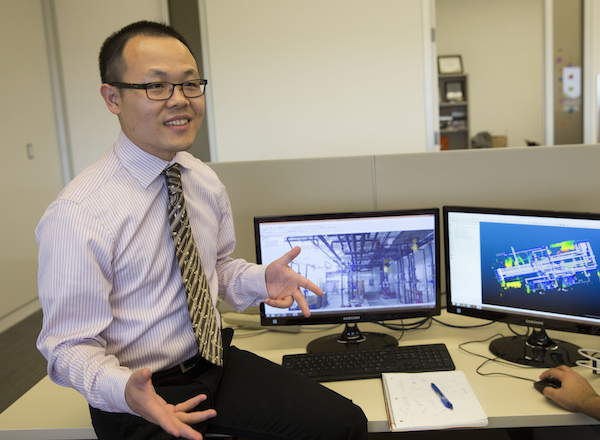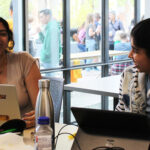
Striving for stronger structural sustainability

A National Science Foundation CAREER Award will enable Pingbo Tang to expand his work on techniques to ensure bridges and other civil infrastructure can be maintained more effectively. Photo by Jessica Hochreiter / ASU.
Aging infrastructure is among the most pervasive and critical global challenges. Countries around the world face potentially perilous consequences from the corrosion of structures on which their transportation, resource management and public safety systems depend.
Arizona State University engineer Pingbo Tang wants to extensively employ advanced technologies as tools for more comprehensive and precise methods of detecting the onset of structural breakdown, predicting its spread and providing data to ensure the most effective repair strategies.
Tang’s work in this area will now be supported through a National Science Foundation (NSF) CAREER AWARD he recently received.
The awards go to young engineers and scientists in the early part of their careers who are considered potential education and research leaders in fields of expertise that could serve national interests.
Imaging and analytics
Tang is an assistant professor in the Del E. Webb School of Construction in the School of Sustainable Engineering and the Built Environment, one of ASU Ira A. Fulton Schools of Engineering.
His research involves the use of advanced sensing and information modeling technologies to produce the analytics necessary for construction-quality management and maintenance of civil infrastructure systems.
The NSF award is providing him about $500,000 over five years for a project titled Risk Monitoring of Civil Infrastructure Using Correlated Change Patterns in Spatiotemporal Data.
Tang will use the latest laser-scanning technology to produce three-dimensional images that more meticulously track changes over time on the surface and within various structures.
Advanced computational tools will then be used to analyze the data provided by such imaging. The data will in turn be used to guide development of solutions to structural deformation and decay.
Forecasting risk factors
The project will focus primarily on bridges, but also look at water towers and offshore drilling structures. Tang’s goal is to vastly improve the ability to predict what degree of threat is posed by even the smallest changes in the materials that make up those structures.
“We want to be able to understand, for example, how specific kinds of cracks will grow, how certain crack formations may be related to each other, and how different cracks might impact an entire structure,” Tang said.
Most bridge inspection methods used today still rely to a large extent on human observation, which often provide no more than what Tang describes as a “snapshot” of structural conditions. He wants to instead provide “change correlation images” that will reveal how changes occurring throughout a structure may be interconnected.
“Cracks or crevices that form in the materials of a bridge may have formed because of problems with stress or misalignment in another part of the bridge. Or some cracks and crevices may have a displacement or deforming impact on another part of the bridge,” Tang explained.
His laser-scanning technique and computational data analysis methods will be designed to more readily identify such conditions and forecast the speed, patterns and severity of decay – and possibly collapse – that will happen unless repairs are made.
Economic advantage
Tang’s project will involve studies of at least 25 bridges in China and Korea, and in New Mexico – and possibly additional ones in Arizona and Pennsylvania – places where there are various types of bridges offering a broad spectrum of structural problems to examine.
Results from the his development of improved structural analysis methods are expected to be applicable not only to maintaining other structures, such as dams, but to contribute to endeavors in aerospace engineering, biomedical engineering and materials science.
Countries that can develop and employ such advances to ensure infrastructure sustainability will have significant advantages economically and otherwise, “so the NSF would like the United States to become a world leader in this area,” Tang says.
The project also entails an array of education efforts. Plans are to develop a hands-on summer workshop to introduce high school students to the technologies being increasingly used today in the civil engineering field.
There will be education outreach to industry, and Tang will maintain a website to make his research findings available to the public and industry.
Education goals
For the summer workshop and the website, he will create computer games to teach different audiences about his research.
He also will develop education models to enable ASU, as well as other universities, to incorporate results of his project into course curriculum.
In addition, an ASU engineering doctoral student will have an opportunity to assist Tang with his project, and an engineering master’s student will help him manage and instruct the summer workshop.
Tang is an associate editor of the Journal of Computing in Civil Engineering, published by the American Society of Civil Engineers.
He earned a bachelor’s degree in civil engineering and a master’s degree in bridge engineering from Tongji University, Shanghai, China.
He later earned a doctoral degree from the Advanced Infrastructure Systems group at Carnegie Mellon University and completed postdoctoral training in the Mapping and GIS (Geographic Information Systems) Lab at Ohio State University.
Before joining ASU, he was an assistant professor of civil and construction engineering at Western Michigan University.
Media Contact
Joe Kullman, [email protected]
480-965-8122
Ira A. Fulton Schools of Engineering



































